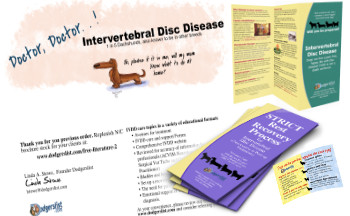Melanie, with the use of the word "physio" sounds like you are not in the USA.
What country is Higgins in?
It is for the health of the bladder that you use your hands to express the bladder.
--Over extention of the bladder (a very full bladder) can ruin its muscle tone. Then when bladder control returns, bladder may not fully function as it should.
-- Remaining urine that an overflowing bladder leaves, means that old urine could quickly become a breeding ground for bacteria (UTI).
BLADDER EXPRESSINGPleased to hear you caught on to poop expressing! Good job.
Please do watch the video on expressing, so you get the idea of where to place hands. Then get more out of another lesson. Get the expressing lesson at your own vet or where the surgery was done on Monday
---The kind of expressing lesson should be the vet or vet tech putting their hands on top of your hands.
--Learn the amt of pressure to apply to get the neck of the bladder to open up for escape of the urine.
-- Learning by feeling the bladder in all stages of emptying what it's shape is and where it might be located.
-- A very full bladder, you won't feel the shape as the whole tummy area will be filled with the bladder. It won't take much pressure to release urine. In fact, just lifting Higgins would cause him to leak on you OR the pressure of the sling over his belly area would cause release of urine.
-- As the bladder gets smaller it evenually ends of feeling like the size of an small plum. It hides back in the pelvic area. You fingers need to feel around to bring the little bladder back into your hands for more pressing. Get out as much urine as possible to make the next expressing session be a longer time. And importantly, so there is not much urine to become a breeding ground for a urinary tract infection (UTI).
Help 'em up Harness is a good one to use for the rear legs!
If the surgeon has directed that during post-op rest he wants Higgins to be able to walk with his front legs type of exercise. Or if you do not want to express the bladder inside the house, but outdoors in the grass/snow, use a rear sling to get him out there. Most of us express in the house in the bathroom where there are no distractions for the dog and we are in a nice warm environment!!
IF Higgins is too much weight for you to safely carry, then there are options for training to use a pee pad just adjacent to the recovery suite.
🚩Check out more ideas for dogs not safely or easily carried here:
dodgerslist.com/2022/02/10/large-dog-care-tips-ivdd/DIFFERENTIATE BETWEEN REFLEX AND VOLUNTARY MOVEMENT.
1) SNIFF and PEE test for bladder control
The "sniff and pee test" is the only way for humans to determine whether bladder control exists. Carry the dog outdoors, set him down on an old pee spot for a sniff. Make sure that neither the sling nor your hands are on the stomach region as this could put pressure on the bladder. If urine comes out after sniffing, bladder control is returning. Until you are certain that full voiding is always occurring, continue to do a quick express check after dog pees. Tell us what you observe.
NOTE: When the bladder is full, it fills the entire area of the abdomen; therefore, any pressure can cause the bladder to release urine for dogs who do not yet have bladder control. It might be necessary to maintain the pressure for a little longer than you anticipated. The bladder shrinks as it empties, making it more likely to escape your grasp. Feel around for it once more. A small bladder can move back toward the pelvic region. Continue pressing the bladder until it feels so flat, that one hand can almost touch the fingers of the other hand.
2) Other parts of the body: reflex or voluntary?For us humans to be able to distinguish between reflex and brain directed,
we have to see some sort of head level involvement with the tail, with a limb or with release of urine so we know the movement was done with purposeful thinking.
---
Sniff (head level nose) on an old peed spot, then release of urine would be brain directed.
---
Hear (head level ear) you doing some happy talk and then tail wags is brain directed. Tail movement during potty time can often be a reflex
---
Itchy sensation at neck and then tries to scratch would be purposeful movement. Tickling paws, etc can cause reflex leg movements of pushing in or out.
Here is more on
spinal walking. Only dogs who do not have Deep Pain Sensation (DPS) might be able to learn to walk via reflexes of the spinal cord.
🚩https://dodgerslist.com/2021/09/27/spinal-walking/
Verify for us that since 12/28 surgery, at some point DPS has come back and Higgins can truly give you a happy tail wag:
Will he wag if you do some happy talk to him excluding potty time? Leg, tail and other movements you may see at potty time could be reflex related and not voluntary. Trust only the word of your neuro about DPS. Once DPS has come back, anyone can be trusted to verify a happy tail wag.
Nerves heal typically in the reverse order of the damage to the spinal cord:1.
Deep Pain Sensation: the first neuro function to return.
DPS is the critical indicator for nerves to be able to self heal after surgery or with conservative treatment.
Trust only the word of a neuro (ACVIM) or ortho (ACVS) surgeon about this very tricky to correctly identify neuro function.
2.
? Tail wagging with joy at specifically hearing happy talk, seeing you or getting food.
3.
? Bladder and bowel control verified with the "sniff and pee" test.
4.
Weak leg Movement, and then
ability to move up into a standing position, and then
wobbly walking.
5.
Being able to walk with more steadiness and
properly place the paw without it knuckling under.
6. Ability to walk unassisted and perhaps even run. LEARN MORE:
dodgerslist.com/2021/02/06/nerve-healing-after-disc-episode/Knuckling:
thumb.ibb.co/k3dqRS/Knuckling.jpgVery interested to hear your report if happy talk gets you a happy wag!




 **
** 




